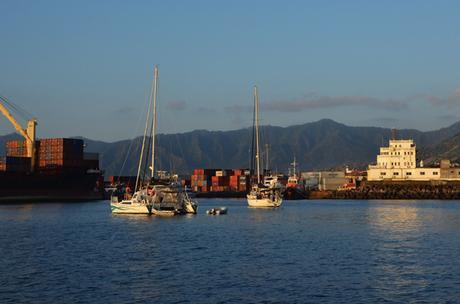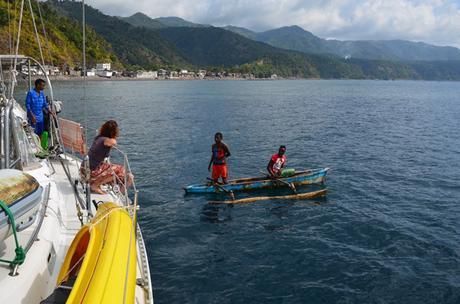
“STAY AWAY FROM THE PROPELLER!” From below deck I heard Jamie shout from the cockpit, and froze. It was our last day in Comoros; our sixteen year old son, Niall, had just left with the dinghy– those words could only mean one thing, and it terrified me. Niall was in the water, and the outboard prop was still dangerously spinning.
He had departed Totem moments earlier for a late afternoon meet-up with friends on a neighboring boat while we entertained a group of NGO workers on board. Wind coming down the hillside to the harbor gusted 25-35 knots, causing the anchorage to chop up. Three things happened as Niall pulled away in our RIB: 1) a strong gust hit the dinghy on the nose, 2) the dinghy’s bow was lifted by a wave, and 3) Niall throttled up to get underway. Without weight in the bow, these three factors combined to lift the dinghy to a near vertical position in the water. Knowing his weight could literally tip the scale and not wanting to be underneath and overturned dinghy, Niall bailed out.
We first experienced a runaway dinghy in the summer of 2009, not even a year into cruising. A visitor to Totem started his outboard up without realizing it was in gear, was immediately thrown in the water while the tender churned circles in the water right next to him. Jack could easily have been killed, and gave us an early lesson in the importance of wearing the kill switch cord even before the engine is started. Earlier this year, a cruiser in Mexico had his lower leg amputated after a man-vs-dinghy prop accident. The USCG reports more than 150 prop-related injury accidents in 2014, of which 22 of were fatalities.

No outboard? No problem. Boys visiting by dugout in Anjouan, Comoros.
A kill cord should be worn every time the dinghy is used. I’m embarrassed to admit we usually don’t use ours: there is no excuse for skipping a simple safety precaution that saves lives. We need to take it seriously, and model that for our kids.
My usual, lame reason for not having the kill switch on is that it’s hard (impossible for me) to start the outboard while wearing it. So I start the outboard, then put it on- IF I’m not distracted by the usual chaos of loading / unloading / untying / disentangling from nearby painters / etc. There’s a great idea from Carolyn Shearlock on The Boat Galley: put the lanyard around your ankle instead of your wrist. For me, that solves the problem of being a weakling who needs both hands to pull the start.
Imagining Niall in the water with a prop spinning nearby is right up there on my scale of worst nightmare events on Totem. I didn’t yet know he had the presence to cut the outboard before jumping out, which was masked by the noise and chop from the wind and water. He got back in the dinghy, back to Totem, tied up and climbed aboard. Calm as a cucumber, it was only as he stood dripping while I hugged him that adrenalin take over in full-body shakes.
Other than shattered nerves, the only fallout from this accident was the loss of a computer. Niall had packed up a laptop and accessories into a backpack to use for games on the other boat. It’s a water resistant backpack, but it’s not intended to be waterproof – much less submersible. The computer is toast.
Normally, I’m pretty possessive of our tech devices on board. They aren’t cheap and we rely on them: this was the kids’ primary computer for learning and held all the books, videos and tracking for their Khan Academy math lessons, literature, and more. Fortunately Jamie is a data recovery ninja and managed to recover files from the hard drive, even though the directory structure is ruined. But we can’t replace this computer right now, which stinks. Honestly? I could really give a damn, because it is just too easy for me to think of other, far more devastating outcomes to that spill in the bay than a lost laptop. Maybe we needed a lesson that would stick.
It’s been three weeks since the accident, but it’s taken me those weeks to be able to put what happened in writing. I’m grateful to be able to share our adventures to help fuel the dreams of others who aspire to the cruising life. And sometimes, I think that my generally ebullient view on the cruising life – how much we enjoy it, how very good it is, the miles and countries and experiences we’ve chalked up – may make it seem like we have the answers. We don’t have the answers, we screw up, and sometimes we screw up in a pretty big way.
This post is syndicated on Sailfeed.

